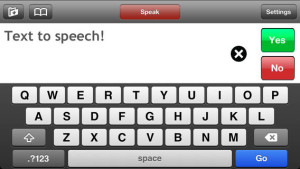Last semester when I was student teaching at my special education placement I was really amazed at the use of technology to bridge the language gap with students with special needs. For two periods of the day my cooperating teacher and I worked with three students with varying disabilities on math and literacy. One student in particular was nonverbal as a sixth grader so communicating with him was obviously very difficult. In his IEP (individualized education program) he was given technological services to help him communicate with teachers, peers, and all adults. He was given a personal iPod in which he used text to speech software. This was a huge help for all related parties since he would often get very frustrated when he wasn’t having his needs met. For example, he had been suffering from an ear infection for weeks and it wasn’t until he was able to use his iPod to communicate that he finally got help for the infection. Much of the classroom instruction was adapted to accommodate his specific needs and to incorporate the use of his iPod. He was given word cues so that he knew when he was expected to use his iPod. For example when he was expected to read something out loud he would be asked to “insert into his iPod”. If he was expected to read a line from a text he would be prompted with “read’.

A big achievement for him while I was there was individually writing sentences in his iPod to express his wishes. Since no one knew how to understand when he wanted a drink or to go to the bathroom, a big achievement was when he was able to write those sentences into his iPod. The assistive technology really helped to reduce his frustration levels while also educating him. To reduce the amount of distractions, his parents would simply put parental controls on the iPod so that he couldn’t go on other applications on the device and could focus on using the text to speech software.
Since this technology worked so well with this particular student the teachers and administration began to incorporate more text to speech software for the other students in the classroom. Another student had difficulties articulating his words and was often difficult to understand. The speech pathologist began to work with this student on using a different type of software that was based on associating pictures with words. He used a machine called a Dynavox. Overall both of these technologies were really beneficial to the students in communication and modifying the lessons to meet their needs.

